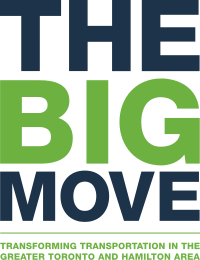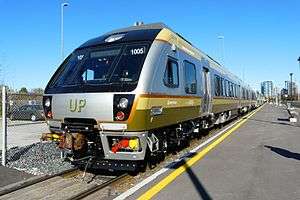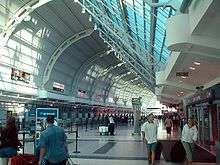The Big Move
 | |
|---|---|
 The GTHA consists of (left to right; west to east): the City of Hamilton, Halton region, Peel region, City of Toronto and York region, Durham region. | |
| Created | September 26, 2008 |
| Ratified | November 28, 2008 |
| Author(s) | Metrolinx |
| Purpose | Regional transportation plan |
The Big Move is the regional transportation plan (RTP) published by Metrolinx for the Greater Toronto and Hamilton Area (GTHA) in Ontario, Canada. It makes specific recommendations for transit projects, resulting from seven "green papers" and two "white papers" released for public discussion. A draft RTP was released alongside draft investment strategy in September 2008. After a series of stakeholder consultations and public meetings, the final RTP was approved and published by Metrolinx on November 28, 2008.
Since its publication, it has been Metrolinx's mandate to implement the RTP, which includes new and improved GO Transit service, local rapid transit, stations, and fare payment systems.
History
There was widespread consensus by community and business leaders in the GTHA that incremental change of the region's transportation system was insufficient, and that it needed a dramatic transformation to meet the needs of the 21st century. The regional transportation system needed to be effective, integrated, multi-modal, and funded in a sustainable way. In response to these concerns, the Government of Ontario created the Greater Toronto Transportation Authority in 2006, which became known as Metrolinx in December 2007.[1] Metrolinx was given the mandate to develop and implement an integrated multi-modal transportation plan for the GTHA, and The Big Move was one of Metrolinx's first deliverables.[1] The plan builds on the $11.5 billion MoveOntario 2020 commitment by the Government of Ontario announced on June 15, 2007, and includes new projects to support them.[2][3][4]
An initial stage of the RTP process was to release a series of "green papers", documents covering key issues for the RTP. These green papers were developed and consulted upon in late 2007 and early 2008, with the purpose of presenting information on transportation trends, challenges and opportunities for the GTHA:[1]
- Paper 1: Towards Sustainable Transportation
- Paper 2: Mobility Hubs
- Paper 3: Active Transportation
- Paper 4: Transportation Demand Management
- Paper 5: Moving Goods and Services
- Paper 6: Roads and Highways
- Paper 7: Transit
The next stage was the release of two white papers in May 2008. Paper 1 - Visions, Goals, and Objectives, presented the basis for the final RTP, with specific goals and objectives that could be used for its development and evaluation. A broader proposed vision for the entire system was also presented. Paper 2 - Preliminary Directions and Concepts, looked at various policies, programs and tools that could be utilized in the RTP. There were also various transportation system concepts that were modelled and evaluated based on resulting transit ridership, urban congestion, and the emission of greenhouse gas and other air pollutants.[1]
A draft version of the Regional Transportation Plan was provided to Metrolinx on September 26, 2008. A final version was approved on November 28, 2008.[3]
Purpose
| Forecasted Impact of The Big Move[5] | |||
|---|---|---|---|
| 2008 | 2031 | ||
| Without RTP | With RTP | ||
| Population | 6 million | ||
| Automobile driving distance* | 26 km | 25 km | 19 km |
| Rapid transit system length | 500 km | 525 km | 1,725 km |
| Total transit trips annually | 546,000,000 | 798,000,000 | 1,270,000,000 |
| Daily trips during morning rush hour | 467,000 | 682,000 | 1,100,000 |
| % rush hour trips taken using transit | 16.5% | 16.4% | 26.3% |
| % rush hour trips taken walking or cycling | 9.0% | 9.0% | 12.5% |
| % population within 2 km of transit | 42% | 47% | 81% |
| Commuting time* | 82 min | 109 min | 77 min |
| Transportation greenhouse gas emissions* | 2.4 t | 2.2 t | 1.7 t |
| Transportation energy consumption* | 26.4 GJ | 24.9 GJ | 19.1 GJ |
| *Average per person | |||
The GTHA is Canada's largest and fastest growing urban region, with a population forecast to grow by 2.6 million people by 2031.[6] The region is becoming increasingly dependent and designed for automobiles, and traffic congestion is already costing commuters and the economy billions of dollars every year. Nine individual local transit agencies and one regional transit agency exist, and are poorly integrated when one out of four trips crosses a regional boundary, making transit unattractive.[7] Investment in transit has been relatively stagnant, causing roads, highways and transit vehicles to be crowded and pushed to the limit.[8] In the face of climate change, increasing energy costs, increasing urbanization, and an aging population, the RTP exists to alleviate these problems.
Impact
The Big Move conducted modelling to forecast what the impact of its implementation would be in the year 2031. The proposed regional rapid transit and highway network was expected to achieve significant benefits, even with the additional population. These benefits included reduced commuting times, increased active transportation and reduced environmental impacts.[5]
Priority actions
Expanding rapid transit
The region's transportation infrastructure has been characterized as neglected from under-investment. The core of the RTP is building a seamlessly integrated regional rapid transit network consisting of 62 different rapid transit projects. These projects form two long-term templates with 15 and 25 year horizons. These templates outline broad projects; specific details about technology, alignment, stations and service levels for each project are subsequently determined though a cost–benefit analysis, or an environmental assessment process.[9][10]
Connectivity to Pearson Airport



Having high-order transit connectivity to Toronto Pearson International Airport is the second priority action in the Big Move. The RTP identifies the following transit corridors, some of which are now in planning or construction:[11]
- Eglinton Crosstown line
- Finch West LRT
- Mississauga Transitway
- Queen Street, Brampton/Highway 427
- Highway 427 from Kipling Station
With Pearson Airport and Union Station in downtown Toronto being seen as the two most important mobility hubs in the GTHA, the RTP specifically identified an airport rail link as being necessary between them. Discussions and studies regarding a transit link to the airport had been ongoing since the 1980s. Transport Canada began formal calls for proposals in 2001, and a contract was awarded in 2003.[12] The public-private partnership was called off in 2010 after failed negotiations, and Metrolinx was handed responsibility for the project.[13][14] The Union Pearson Express was completed and began operations on June 6, 2015, offering a 25-minute journey that departs every 15 minutes.[15]
Expanding Union Station
.jpg)
Union Station is Canada's busiest passenger facility and "the heart of the GTHA’s transportation system", handling 240,000 people daily, or 65 million annually.[16] However, it has been forecasted that passenger traffic is expected to quadruple in the next 25 years as a result of improvements that are called for in The Big Move, and Union Station will be at or over capacity without dramatic modifications.[16][17] Furthermore, being a National Historic Site that was built and opened in 1927, the station has been showing its age: peeling paint, cracked and damaged floors, leaky roofs, and crowded and inefficient passenger concourse spaces that were designed in the 1970s.[18][19]
The current work being undertaken includes excavation work to dramatically expand the existing GO and Via Rail concourses and create a floor dedicated to retail space, establishing new connections to the PATH network, increasing the number of entrances, implementing energy efficiency measures and restoring heritage elements.[19] Future work could include a new train tunnel for the GO Transit Lakeshore lines, with a new station being built slightly east of Union.[17]
Integrated transit fares
There are 10 public transit agencies in the GTHA with individual fare systems. This forced some commuters to have multiple fare payment types. The Ontario Ministry of Transportation began trials for Presto, a regional fare card, in 2007. Presto was later made an operating division of Metrolinx. Presto is available on GO Transit, the Union Pearson Express, and seven municipal transit agencies in the GTHA (Brampton, Burlington, Durham Region, Hamilton, Mississauga, Oakville and York Region). Some TTC routes and subway stations are also Presto-enabled, with the goal of making it available across the entire TTC system by the end of 2016.[20] Fares are often cheaper than standard cash fare, and most municipal transit agencies will reduce their fare to between $0.50 and $0.75 for transferring to GO Transit.[21]
There are 10 unique fare structures across the GTHA. Metrolinx is also working towards establishing one single fare policy across the region, with the objectives to create one fare structure that is simple and easy to understand, and reflective of the distance travelled and the quality of service. Metrolinx is evaluating fare structures that include a flat fare, or differentiations by mode distance or zones.[22][23]
Mobility hubs
A transportation mobility hub is a major transit station and the immediate surrounding area, where different forms of transportation come together, serving as the origin, destination or transfer point for a significant amount of trips. The Big Move calls for "a system of connected mobility hubs” that allow seamless access to and transfers within the regional transit system. The mobility hubs also support higher density development.[24]
Metrolinx has profiled 51 mobility hubs in the GTHA, collecting data within an 800-metre radius of each of them. In some hubs, Metrolinx undertakes detailed studies. For some hubs, these studies provide a broad plan for how the mobility hub should look and work over the long term, by informing more detailed planning, supporting future growth, and ensuring land use and transportation plans are well integrated. In other hubs, these studies address specific station issues in the short and medium term.[25]
Investment strategy
The Big Move was to be accompanied by an investment strategy, in order to ensure that capital costs for the GTHA's regional transportation system were funded in a sustainable way.[1] This would require the generation of $50 billion for all of the identified projects, which equated to $2 billion annually for 25 years. While the RTP outlined the preliminary requirements, an Investment Strategy would be crafted in more detail in separate cover.[26] Metrolinx was given until June 2013 to draft such a strategy.[27]
On May 27, 2013, Metrolinx released its Investment Strategy, which would use the following tools to generate $2 billion annually for RTP projects:[28][29]
- A 1% increase in the Harmonized Sales Tax ($1.3 billion)
- A 5¢ increase in the gas tax ($330 million)
- An average charge of 25¢ on all off-street non-residential parking spaces ($350 million)
- A 15% dedication of all development charges ($100 million)
On September 18, 2013, the Government of Ontario under Premier Kathleen Wynne announced a panel to review the Investment Strategy, in order to "listen to different concerns and views and to assess them."[30] The panel recommended two variant options of Metrolinx's Investment Strategy recommendations, which relied less on a Harmonized Sales Tax increase, and more on a gas tax increase.[31] In March 2014, Wynne rejected the proposal to raise taxes to fund the RTP outright, in the lead-up to the 2014 Ontario general election.[32]
A formal Investment Strategy has not been implemented to date, and the Ontario government has opted to raise funds for transportation project through its green bond program and the partial sale of Hydro One.[33][34]
References
- "The Big Move" (PDF). Metrolinx. 2008. Retrieved 22 April 2015.
- "Approved Changes to The Big Move" (PDF). Metrolinx. 14 February 2013. Retrieved 8 December 2015.
- 1 2 3 4 5 Metrolinx, p. vi-vii
- ↑ "Premier of Ontario - News Release - McGuinty Government Action Plan For Rapid Transit Will Move The Economy Forward". Government of Ontario. 2007-06-15. Retrieved 2007-09-15.
- 1 2 Metrolinx, p. i-ii
- ↑ Metrolinx, Schedules 1 & 2
- 1 2 Metrolinx, p. 58-59
- ↑ Metrolinx, p. 3
- ↑ Metrolinx, p. 6
- ↑ Metrolinx, p. 7
- ↑ Metrolinx, p. 22
- ↑ Metrolinx, p. 96
- ↑ Metrolinx, p. 24
- ↑ "Transport Minister Announces Winning Proposal for Toronto Air-Rail Link" (Press release). Ottawa: Transport Canada. 2003-11-13. Archived from the original on 2011-11-30. Retrieved 2011-11-30.
- ↑ Kalinowski, Tess (2010-07-31). "Province vows rapid rail link to Pearson by 2015 Pan Ams". The Toronto Star. Toronto. Archived from the original on 2011-11-30. Retrieved 2011-08-08.
- ↑ CNW Group (30 July 2010). "Metrolinx to build, own and operate Air Rail Link". CNW Group. Retrieved 8 August 2011.
- ↑ "Union Pearson Express to Launch June 6". Government of Ontario. Retrieved 22 April 2015.
- 1 2 Metrolinx, p. 25
- 1 2 "Union Station 2031 and Related Planning Studies" (PDF). Metrolinx. 23 November 2011. Retrieved 24 June 2012.
- ↑ "About Union Station". City of Toronto. Retrieved 24 June 2012.
- 1 2 "About the revitalization". City of Toronto. Retrieved 24 June 2012.
- ↑ TTC PRESTO Fare System
- ↑ About PRESTO
- ↑ Metrolinx - Fare Integration
- ↑ Metrolinx Board Presentation - Towards a Regional Fare Policy
- ↑ "Metrolinx Mobility Hubs". Metrolinx. Retrieved 28 November 2012.
- ↑ "Mobility Hub Profiles". Metrolinx. Retrieved 14 December 2015.
- ↑ Metrolinx, p. 68-74
- ↑ Will province drag its feet on regional transit taxes?
- ↑ STABLE FUNDING TO INVEST IN OUR REGION
- ↑ INVESTMENT STRATEGY
- ↑ Province announces advisory panel to review Metrolinx investment strategy
- ↑ Hike gas tax to pay for new Toronto transit, panel recommends
- ↑ Ontario won't hike HST or gas tax to pay for transit, Wynne says
- ↑ Strong Demand for Ontario's First Green Bond
- ↑ $1.6B Hydro One stock issue rises in TSX debut




_(14918534190).jpg)